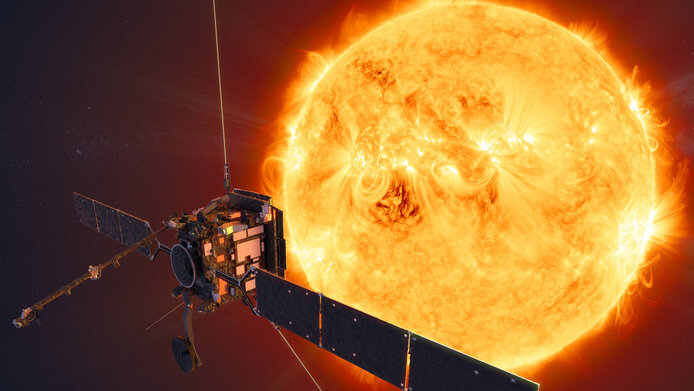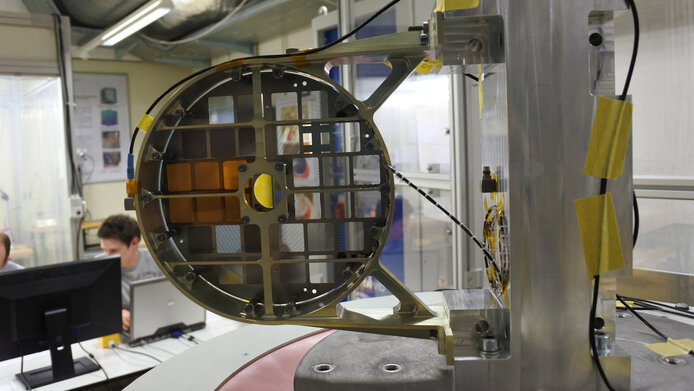Flying close to the Sun

One can hardly overestimate the importance of the Sun for the Earth. Not only do we owe it the very existence of our planet, but life on Earth – at least in the form we know it – would also be unthinkable without the Sun. Unsurprisingly, therefore, the Sun has aroused scientific interest since time immemorial. Accordingly, we know this home star of ours very well; we know about its size, temperature and age, and we understand which thermonuclear processes that generate energy take place in its inner core. We also know that the Sun has already expended almost half of its anticipated lifespan of ten billion years. And yet, it still has puzzles in store for researchers.
Enigmatic aura
Sometimes the unanswered questions of solar physics lead all the way to Austria, as was the case when Northern Lights were visible even here on some nights this year. The spectacularly luminous phenomena occur when the solar wind interacts with the Earth's magnetic field and the oxygen and nitrogen atoms in the atmosphere start to glow because they are excited by high-energy particles.
This stream of particles, known as the solar wind, does not always blow with the same vigor: when the Sun is particularly active it sweeps through space more forcefully and can trigger auroras that even reach our latitudes. But where does the solar wind come from? “We know that the solar wind comes from the corona. This is the area around the Sun that becomes visible as a glowing white outer ring during a total solar eclipse,” explains Astrid Veronig, Professor of Solar Physics at the University of Graz.
“The corona has temperatures of one to two million degrees Celsius, and the surface of the Sun is significantly cooler at around 5,500 degrees,” Veronig continues. “This means there are processes that transfer the kinetic energy from the surface of the Sun to the corona – and thus ultimately also provide the energy to accelerate the solar wind.”
Astrid Veronig is Professor of Solar and Heliospheric Physics at the University of Graz. She is also the director of the Kanzelhöhe Observatory.
More information
Cosmic home
But the solar wind does not just create breathtaking Northern Lights. In conjunction with the Sun's magnetic field, the particles constantly streaming outwards from the Sun form a gigantic bubble around the solar system, known as the heliosphere. The pressure of the solar wind prevents high-energy particles from interstellar space to enter the heliosphere, and acts like a protective shell around our cosmic home.
The weather in the heliosphere can also be rough: driven by the Sun's dynamic magnetic field, there are regular bursts of radiation, known as solar flares. If these are particularly strong, parts of the Sun's magnetic field can detach and sweep large quantities of solar plasma into space.
Such mass ejections from the corona can sometimes be a hazard for us: “First of all, infrastructure that is in space, i.e. satellites, is directly exposed to solar storms,” notes Veronig. While this constitutes a disaster in itself in the information age, things can get even worse, as Veronig knows: “If the magnetic field carried by the solar storm merges with that of the Earth, the Earth's magnetic field can be weakened for several hours or days. This can allow high-energy particles to penetrate the atmosphere, while the fluctuating magnetic field induces strong currents in the ground and in cables.”
It is precisely the latter that makes such geomagnetic storms so dangerous for our power grid and IT infrastructure. Understanding solar storms is therefore not only in the interest of basic research, but also helps us to understand the circumstances under which storms arise in space.
Focusing on the flares
Veronig and her team therefore want to investigate exactly which processes pump energy into the solar atmosphere. To this end, they are focusing on flares, i.e. bright bursts of radiation, which they can observe from close up thanks to the Solar Orbiter.
Solar Orbiter is a space probe from the European Space Agency (ESA) that orbits the Sun in highly elliptical orbits. The probe flies as close as a third of the distance between the Sun and the Earth, bringing it closer to the Sun than the planet Mercury. It carries ten scientific instruments, well protected behind a heat shield, which observe the Sun.
STIX, an X-ray telescope in which Veronig is involved, sits behind one of the observation windows. “STIX can take images of the Sun in the X-ray range and analyze the emitted wavelengths. However, as the wavelength of X-rays is so short and high in energy, we cannot use the usual lenses or mirrors as in conventional telescopes,” explains Veronig.
Accordingly, STIX is an unusual telescope. Veronig: “We use a set of over thirty fine tungsten grids and calculate the location and structure of the source from the pattern that an X-ray source casts on the detectors behind the grids.” STIX can also record the spectrum of the source, telling the researchers how the radiation is distributed over different wavelengths.
Accelerated electrons
“We measure the radiation spectrum, which enables us to draw conclusions about the energy distribution of the high-energy electrons that cause this radiation. We are particularly interested as to where and how the energy is released,” says Veronig. The X-rays under observation are produced when electrons in the corona are accelerated by the Sun's magnetic field during a burst of radiation.
This process involves two populations of particles: the radiation observed by STIX is triggered by high-energy electrons that are hurled from the corona towards the surface of the Sun. When they hit the denser plasma there, the particles emit X-rays. Something similar happens in X-ray machines, where electrons are accelerated with electrical voltage onto a heavy tungsten layer and emit so-called "bremsstrahlung" when they hit it.
“On the one hand, STIX sees the bremsstrahlung of the electrons that return to the Sun along closed field lines. On the other hand, the strength of the Solar Orbiter lies in the fact that the probe also has instruments that allow in-situ measurements,” notes Veronig. This enables the space probe's measuring instruments to record the second particle population, which is accelerated away from the Sun along open field lines.
New insights ...
The Solar Orbiter has been orbiting the Sun since 2020. What are the findings of the mission so far? “Based on our observations, we know that a lot of energy is released from the magnetic field in the corona during flares due to the reconnection of the magnetic field,” explains Veronig. “This heats up the solar plasma to many millions of degrees for a short time and particles can be accelerated.”
Veronig and her team also discovered that flares with very hard X-ray spectra occur when one of the footpoints of the magnetic arcs is located directly in a sunspot. “Sunspots are dark areas on the surface of the Sun that are lower in temperature than their surroundings. The magnetic field, on the other hand, is particularly strong in these areas,” explains Veronig.
If a flare is now connected to a sunspot via one end, even smaller flares can have a hard spectrum and strongly accelerate particles. Veronig and her research team were also able to develop new methods for modeling the processes in the magnetic field and narrow down the location of the energy release.
... and outlooks
“The energy is released in the corona, where we cannot measure the magnetic field directly due to the low density and high temperatures. As we can only do this on the surface of the Sun we have to rely on models. One of the things our model calculations show well is where energy is stored and what structural changes cause it to be suddenly released,” is how Veronig summarizes the findings.
Meanwhile, Solar Orbiter embarks on an exciting phase of the mission: in the context of several fly-by maneuvers on Venus, the probe is collecting energy that will carry it out of the ecliptic, which is the imaginary plane on which all the planets in the solar system orbit.
By leaving the ecliptic, Solar Orbiter will be able to take a closer look at the poles of the Sun in around two years' time. Experts hope that these observations will provide further insights into the complex magnetic field of our home star – and, perhaps, more mysteries.
Personal details
Astrid Veronig is Professor of Solar and Heliospheric Physics at the University of Graz. She is also the director of the Kanzelhöhe Observatory. After studying astronomy, physics, philosophy and German studies, she completed her doctorate on solar flares in 2002. After a research stay at NASA's Goddard Space Flight Center, Veronig acquired her professorial qualification at the University of Graz in 2009, where she took up her professorship in 2020. With the support of the Austrian Science Fund FWF, Veronig plays a leading role in the STIX instrument on board ESA's Solar Orbiter.
Publications
Purkhart St., Veronig A.M., Kliem B., Jarolim R. et al.: Multipoint study of the rapid filament evolution during a confined C2 flare on 28 March 2022, leading to eruption, in: Astronomy & Astrophysics 2024
Gou T., Liu R., Su Y. et al.: High-Resolution Observation of Blowout Jets Regulated by Sunspot Rotation, in: Solar Physics 2024
Saqri J., Veronig A.M., Battaglia A.F.: Efficiency of solar microflares in accelerating electrons when rooted in a sunspot, Astronomy & Astrophysics 683, 2004, A41
Purkhart S., Veronig A., Kliem, B.: Multipoint study of the energy release and transport in the 28 March 2022, M4 flare using STIX, EUI, and AIA during the first Solar Orbiter nominal mission perihelion, Astronomy & Astrophysics 479, 2023, A99






